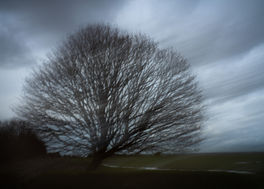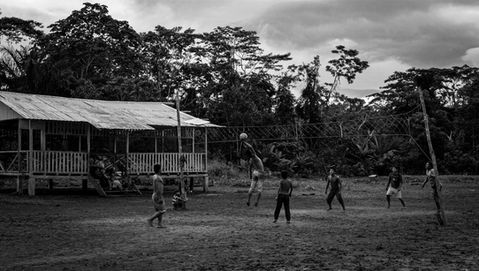SOLO
Solo exhibition | Yoray Liberman
Curator: Michal Krasni
To observe is to be open—to agree not to understand immediately, not to rush to interpret or to judge. It is a decision to be present, not only in front of the lens but also in front of yourself.
For more than two decades, Yorai Lieberman has been walking the paths of the world with a camera. He moves between continents and cultures, capturing everything from dramatic events to tranquil everyday moments. Alongside his journalistic pursuits, he lingers, remains, and documents even what is not considered newsworthy
The Solo exhibition presents five selected projects from Lieberman's personal archive. Three series were photographed in Afghanistan, Ecuador, and Turkey, each telling a story about a community, sometimes on the fringes of society or at the heart of conflict. The photographs reveal the diversity, the internal tensions, the complexities of life, the fragility, and the changes that occur, raising questions about identity and belonging
The fourth series, TO:GATHER, presents photographs from gatherings and public events in various locations. Through these, Lieberman examines the relationships between the individual and the surrounding group, and especially what drives people to 'follow' an idea and become part of the crowd.
The fifth series, which is new, is displayed in the upper gallery space with a view of the Jaffa shores, unveiling creations that dance at the edge between photography and painting. Lieberman steps away from the human crowd and turns to the quiet of the open spaces in western France. This offers a different kind of reflection—slow and thoughtful—that allows for a moment of pause in front of nature and light.
The series of works in the exhibition follows Lieberman's continuous journey. Each photographed series represents another step in his personal quest to comprehend the complexities of another's life and to attempt to integrate himself. In every interaction, whether it takes place in a politically charged environment or in everyday moments, questions arise—can a sense of closeness be created? What evokes a feeling of belonging in a person, and how does identification come about? Lieberman directs these questions at himself as well. Thus, every photograph he creates is not just a documentation of reality but an attempt to understand his place within the unfolding events.
In his first solo exhibition, 'Solo,' Lieberman unveils his visual diary, presenting us with a different perspective—not only on what occurred but also on how these events unfolded. This exhibition invites us to perceive photography not merely as documentation, but as a complete work that stands independently, provoking thought, emotion, and empathy.
SLOW PHOTOGRAPHY
As a photojournalist, I have spent years traversing the landscape, capturing the ever-changing tapestry of reality—seeking fleeting human moments and clinging to fragments of truth. In the midst of chaos, I strive to pinpoint The Decisive Moment," a term coined by Henri Cartier-Bresson. This is that fragile instant when everything aligns into a single, powerful, and unforgettable image.
After years of focusing on external realities, something within me fractured. I began to feel that the world doesn’t always crave documentation. Sometimes, it simply asks us to listen. I realized that reality is not just what meets the eye—it is also what seeks to be revealed, quietly, in the space between things, if only we allow it.
From this understanding, a process of slowing down began within me. A pause. A different kind of observation.
I chose to embark on an ancient pilgrimage in Brittany, western France. This land, characterized by wild seas, dense forests, and a spiritual atmosphere where religion, myth, and landscape intertwine. This circular pilgrimage, known as Tro Breizh, is a circular route revolving around seven local saints. It has no clear beginning or end, no destination—only movement and introspection. As I traversed this path, I found a sense of release. The photographs I took, along with the silence that envelops them, embody this journey. I worked with light using long exposures, allowing time to seep into each frame. No longer focused on capturing a moment, I aimed to create space for movement, tenderness, and depth.
The outcome is a collection of images layered with light, evoking a sense of presence—photographs that float between reality and dreams.
The SLOW PHOTOGRAPHY series presents an alternative perspective: it invites viewers to step away from the immediate and transient visuals of daily life, encouraging a shift towards a more contemplative, almost meditative rhythm. Through long exposures, camera movements, and light painting, a new reality is born—an intentional distortion that seeks to provide an internal, emotional lens. This approach allows the observer to experience the resonance of impressionism—not merely as a reproduction of the visible, but as an interpretation of the felt.
Even after completing the photographs, my observation continued. I carefully selected antique frames gathered from various places in France—at the intersection of the image and the frame, another layer of connection emerged.
Transitioning from photojournalism to slow photography is not just a technical shift; it signifies a profound change in awareness. Speed has given way to slowness, and while the figures are momentarily fixed, the flow of time persists. Now, it invites us to engage with it in a different light.

AFGANISTAN
In 2004, I arrived in Afghanistan with a friend, both of us equipped with Israeli passports and cameras.
At that time, coalition forces were engaged in a fierce struggle against the Taliban, while Osama bin Laden and Al-Qaeda fighters were hiding in various corners of the country. Fear and uncertainty hung in the air, yet my curiosity drove me forward with every step. I understood the risks involved, but Afghanistan was the focal point of global interest, and it was important for me to witness the situation up close.
During my time there, I roamed various regions of this rugged country. With a camera slung around my neck, an open heart, and a vigilant mind, I captured everyday life in the markets and narrow alleys of Kabul, traveled to photograph opium fields near the Pakistan border, documented the state of women in the country, and attended the national horse games—Buzkashi. The breathtaking landscapes stood in stark contrast to the prevailing sense of uncertainty and chaos everywhere.
As I traveled through various parts of this wild nation, it quickly became evident that Afghan society is fragmented, made up of diverse ethnic minorities—Pashtuns, Tajiks, Turkmen, Uzbeks, and others. These are patches of communities, often in conflict with one another. The borders of Afghanistan were drawn by historical powers, motivated by colonial geopolitical interests, and their impact is still felt today.
I do not claim to understand Afghanistan. The images I captured do not present an absolute truth but rather human meeting points. Each time I revisit these photographs, I am reminded of the pairs of eyes that looked back at me.
The images in this series resonate with profound questions about power and freedom, intimacy and alienation, and what life entails when every glance and movement can become an act of survival.

SAPARAS
My curiosity about the lives of indigenous communities led me to the jungles of South America. I landed in a tiny plane on an improvised runway deep in the Amazon, from where I paddled for hours in a canoe to reach a remote settlement of the Saparas tribe. My arrival was not by chance; it was an internal journey as much as an external one. To meet a community living in harmony with nature, I had to set aside my habits and cynicism and fully commit to listening.
The photographs in this exhibition emerged from long days spent in the community, observing and bonding with the people. They don’t capture exoticism but rather attempt to seize small moments of truth movement, gaze, ritual, silence.
The Saparas people are not fighting an external enemy; they are confronting a wave of change that threatens to erase their distinct way of life.
This series offers a glimpse into a distant and unfamiliar community. Through their story, I invite viewers to look inward as well. Perhaps for a moment, we can imagine alternative lives, and even ask ourselves: given the choice—where would we like to live? And can such a simple and intimate sense of community exist in our lives, or is it only possible in the jungles?

TURKEY
Turkey lies at the intersection of Europe and Asia, with the Bosphorus—a narrow but mighty strait—serving as more than just a geographical border. It is a living symbol of a multifaceted identity, a meeting point between East and West, past and future, tradition and renewal. Its flow reflects the deep conflict within Turkish society: a long-standing tradition rooted in religious, communal, and patriarchal identity versus the desire to integrate into a secular Western society that values religious freedom, equality, and women’s rights.
During my five years living in Istanbul, I aimed to capture this gap between the two worlds of Turkish society through my camera lens. I wanted to highlight the views of those who see modernity and Westernization as a threat to their religious and cultural identity, in contrast to those who perceive tradition as a barrier to growth, prosperity, and openness to the world.
The series of photographs displayed in the exhibition provides a glimpse into my long-term work, echoing questions of identity and belonging. The images aim to express the internal tension that also accompanies political struggles, the voices calling for change, and the desire of each side to shape the nation in its own image.
In my photos, I strive to hold onto this tension between the two poles. I attempt to capture the duality through gazes, faces, and intimate moments—searching for the questions that arise around identity, change, and belonging. Throughout this time, I felt the unresolved complexity, the ongoing rift between East and West, and the struggle between the old and the new.

TO:GATHER
The dynamic between the individual and the group has always fascinated me—those moments when a person immerses themselves in the crowd, almost dissolving into it, drawing strength and a sense of belonging from the collective.
For years, I have photographed large-scale events around the world: vibrant protests, state ceremonies, pilgrimages, funerals, pride parades, religious celebrations, sporting events, and more. In each of these occasions, I felt the emergence of a new language of bodies, expressions, and emotions—the way the collective narrative envelops the personal, creating a powerful mechanism of identity.
At the heart of this current project is the idea of a group with immense gravitational pull, along with the potential for danger. The recurring story in each photograph captures that elusive moment when the boundaries between the self and the collective blur and sometimes collapse. Alongside the warmth and excitement of belonging, there exists the possibility of erasure and the loss of individuality within the collective.
In this series, I seek to examine what happens when the image is removed from its original context. The crowd transforms into raw material—not as a political or social message, but as a space for deep human expression. The images are not organized by time, place, or context; instead, they coalesce around a narrative and an idea—an attempt to understand the mechanism that makes a person feel belonging.
TO:GATHER is a photographic series documenting the moments when an individual becomes a part of something larger—a link searching for a story to connect with. Through the images presented in this exhibition, I aim to reveal the tension between vulnerability and strength, between the need for belonging and the price it may exact.
The series questions the individual's need to participate in a narrative greater than themselves—the blurred line between personal interest and that of the group, and how a shared story can unify, evoke emotion, but also alienate and exclude the other.




























































